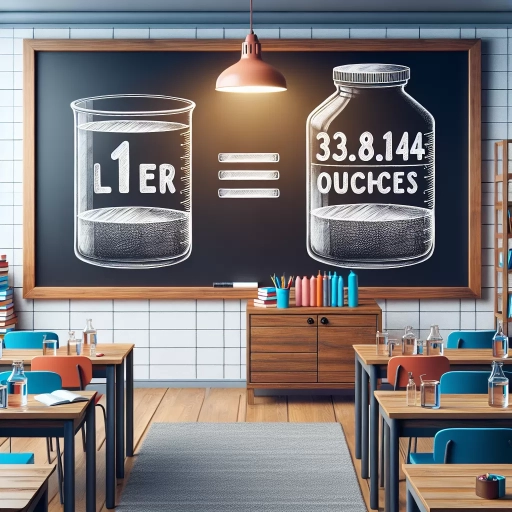How Many Oz In A Liter

Understanding The Basics: What's an Ounce and a Liter?
What is an Ounce?
Ounce is a unit of mass used in most British-derived customary systems of measurement. It is usually abbreviated as oz and comes in two forms - the avoirdupois ounce and the troy ounce. The avoirdupois ounce is the most common type used today and is used in the United States for measures of mass. The use of onzas, Spanish ounces, are also common in many countries that were previously Spanish colonies. Understanding the context of use and the type of measurement system in play is crucial to accurately converting ounces to other measurements such as liters.
What is a Liter?
A liter, abbreviated as L or l, is a metric unit of volume. It is used worldwide for many everyday measurements. For example, in countries using the metric system, beverages and motor fuel are both commonly sold in liters. With its definition being derived from the decimeter (which is a tenth part of a meter), a liter is equal to one cubic decimeter. This equivalence makes it simple to understand the relationship between volume and capacity measurements in the metric system, particularly when converting liters into other units - such as ounces.
The Difference between Ounces and Liters
While both ounces and liters are units of measurement, they each measure different things. Specifically, ounces measure mass, while liters measure volume. The critical distinction here lies in the respective physical properties they measure. "Mass" refers to the amount of matter in an object, while "volume" refers to the amount of space something occupies. While these two properties may seem similar, they differ in essential ways, especially when considering different states of matter (solid, liquid, or gas). Despite these differences, it is possible to convert between these two units – specifically when dealing with fluid ounces and liters, used to measure the volume of liquids.
Conversion Protocols: How Many Ounces are in a Liter?
The Mathematical Conversion
Technically, 1 Liter is equivalent to 33.8140226 US fluid ounces. This conversion rate may vary slightly depending on the standard adopted in different countries. For example, in the UK, 1 Liter is equivalent to 35.19507972 UK fluid ounces. However, for practicality and ease, most people round off these conversion rates to easily manageable numbers. Thus, a common approximation is to consider 1 Liter equivalent to 34 US fluid ounces or 35 UK fluid ounces.
The Practical Conversion
For domestic or non-scientific purposes, it's better to remember approximations rather than exact conversion values. Everything from cooking recipes to mixing cleaning or gardening solutions often uses these approximations. For instance, if a recipe calls for a liter of water, the person cooking could simply measure out approximately 34 fluid ounces. And though it's not 100% precise, these approximations are still incredibly accurate for all practical, everyday uses.
Conversion Tools
In this digital era, various tools can make conversions from liters to ounces and vice versa, with ease. These include online calculators, mobile applications, and conversion tables. Using these tools, one simply needs to enter the quantity in the original unit to receive the converted value. For scientific, academic, or professional purposes requiring exact values, such tools are indispensable.
Common Applications: Why Knowing the Conversion is Useful?
In Cooking
The culinary world is full of recipes from all corners of the globe, each using different units of measurements. Some may use liters while others may use ounces. By understanding how these two measurements relate to each other, individuals can accurately follow any recipe, regardless of where it originated. Knowing conversions can therefore open a whole world of culinary adventures.
In Healthcare
In health care, precise measurements are often required. Whether it's medication dosages, nutritional requirements, or fluid intake and output, each measurement requires accuracy. Becoming familiar with conversions can be beneficial for those in the healthcare industry or those who need to accurately measure fluids at home, like parents or caregivers.
For General Knowledge
In the simple pursuit of knowledge or the satisfaction of curiosity, knowing conversions between different units like ounces and liters is beneficial. This knowledge can be applied in many scenarios – from converting proportions in DIY tasks to understanding measurements in foreign environments.